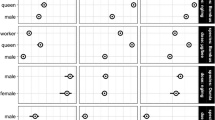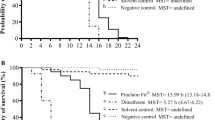Abstract
Intrinsic toxicity of seven insecticides including bromophos, bromophos-ethyl and deltamethrin to the Indian hive bee Apis cerano indica is reported. Bromophos was safer than endosulfan, while deltamethrin was the most toxic.
Résumé
Pour la première fois, les riveaux de toxicité intrinsèque des insecticides comme bromophos, bromophos-ethyl et delamethrin à l’abeille ruchiene undienne, Apis cerana indica sont reportés. Bro¬mophos est plus sauf que l’endosulfan. Deitamethrin était la plus toxique.
Similar content being viewed by others
References
Abbot W. S. (1925) A method for computing the effectiveness of an insecticide. J. econ. Ent. 18, 265–267.
Atkins E. L., Greywood E. A. and Macdonald R. L. (1973) Toxicity of pesticides and other chemicals to honey bees—Laboratory studies. Univ. Calif, agrie, ext. ser. M-26.
Attri B. S. and Sharma P. L. (1969) Toxicity of some new insecticides to Indian honey bee (Apis indica F.). Pesticides 3, 27–29.
Bai A. R. K. and Reddy C. C. (1977) Laboratory toxicity of some insecticides to Apis cerana indica. J. apic. Res. 16, 161–162.
Crane E. and Walker P. (1983) The impact of pest management on bees and pollination. International Bee Research Association, U.K., pp. 45–48.
Goulden C. H. (1952) Methods of statistical analysis. Bombay Asia Ltd, pp. 394–417.
Graves J. B. and Mackenson O. (1965) Topical application and insecticide resistance studies on honey bees. J. econ. Ent. 58, 990–993.
Hameed S. P., Adlakha R. L. and Giamzo S. P. (1973) Relative toxicity of some insecticides to Apis mellifera. Madras agrie. J. 60, 552–556.
Kapil R. P. and Lamba D. P. S. (1974) Toxicity of some important insecticides to Apis cerana Fab. Indian J. Ent. 36, 6–10.
Mishra R. C. and Verma A. K. (1982) Relative toxicity of some insecticides to Apis cerana indica F. workers. Indian Bee J. 44, 69–71.
Pimentel D. et al. (1980) Environmental and social costs of pesticides—a preliminary assessment. Oikos 34, 126–140.
Singh M., Sharma P. L. and Dhaliwal H. S. (1974) Toxicity of insecticides to honey bee workers Apis cerana indica. Pesticides 8, 28–29.
Author information
Authors and Affiliations
Rights and permissions
About this article
Cite this article
Lingappa, S., Jagadish, A., Shivaramu, K. et al. Relative Intrinsic Toxicity of Seven Insecticides to Foragers of the Indian Hive Bee, Apis Cerana Indica F.. Int J Trop Insect Sci 6, 567–568 (1985). https://doi.org/10.1017/S1742758400009103
Received:
Revised:
Published:
Issue Date:
DOI: https://doi.org/10.1017/S1742758400009103




